Thelifeofabutterfly蝴蝶的生长过程
- 格式:ppt
- 大小:979.02 KB
- 文档页数:2
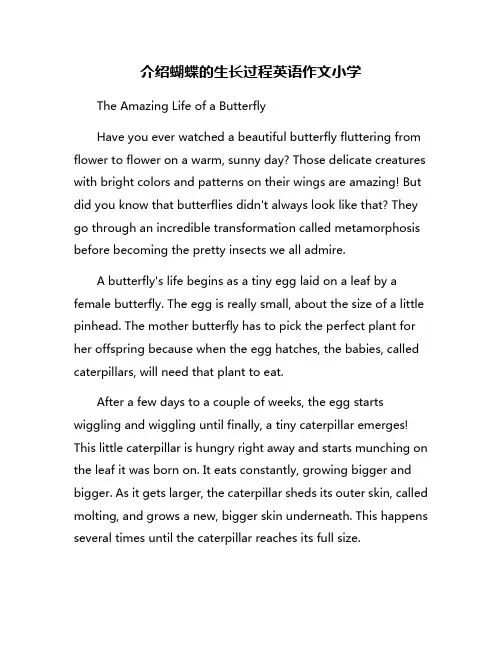
介绍蝴蝶的生长过程英语作文小学The Amazing Life of a ButterflyHave you ever watched a beautiful butterfly fluttering from flower to flower on a warm, sunny day? Those delicate creatures with bright colors and patterns on their wings are amazing! But did you know that butterflies didn't always look like that? They go through an incredible transformation called metamorphosis before becoming the pretty insects we all admire.A butterfly's life begins as a tiny egg laid on a leaf by a female butterfly. The egg is really small, about the size of a little pinhead. The mother butterfly has to pick the perfect plant for her offspring because when the egg hatches, the babies, called caterpillars, will need that plant to eat.After a few days to a couple of weeks, the egg starts wiggling and wiggling until finally, a tiny caterpillar emerges! This little caterpillar is hungry right away and starts munching on the leaf it was born on. It eats constantly, growing bigger and bigger. As it gets larger, the caterpillar sheds its outer skin, called molting, and grows a new, bigger skin underneath. This happens several times until the caterpillar reaches its full size.During this caterpillar stage, you might see one crawling around with an interesting pattern of stripes or bumpy sections. Those patterns and bumps are actually camouflage to help protect the caterpillar from predators like birds, wasps, and other insects who would love to gobble it up. Some caterpillars even have hairs or horns that make them look scary and fierce! But despite their wild looks, caterpillars are just eating machines, not fighters.When the caterpillar is all grown up, it's time for the next step of metamorphosis. The caterpillar stops eating and finds a nice sheltered spot, attaching itself securely to a stem or branch. Then it molts one final time, wriggling and twisting until its outer skin drops off. What's left is an amazing jade green capsule called a chrysalis. Inside this chrysalis, the caterpillar is rapidly changing, breaking itself down into a sort of caterpillar soup!For about a week or two, this chrysalis just hangs there, looking like a little green jewel hanging from the plant. But incredible processes are happening invisibly inside as cells divide and rearrange to create the body parts of a butterfly: compound eyes, two pairs of wings, six legs, a proboscis for sipping nectar, and all the other structures it will need for its next stage of life in the air.Then one day, if you're really observant, you might notice the jade green chrysalis starting to become transparent, with shimmery colors and patterns visible underneath. That's a sign that the chrysalis is about to break open! A few hours or moments later, a miracle occurs—the chrysalis splits apart, and a new butterfly slowly emerges.At first, the butterfly's wings are small, wrinkled, and wet. It has to hang upside down and pump fluids from its body into the crumpled wings until they become large, dry, and firm. When its wings are finally expanded and ready, the butterfly takes its first flight, beginning its new life in a whole new way.A butterfly's main goals are to mate and reproduce more butterflies. The males have to find a female and do an intricate flying courtship dance to try to attract her with his bright colors and patterns. If she accepts him, they will join together and the female will later search for the perfect host plant to lay her eggs so the incredible cycle can begin again.In the meantime, butterflies live by drinking nectar from flowers using their long, coiled tongue called a proboscis. They flutter from bloom to bloom, collecting this sugary liquid to fuel their constant flying. Along the way, the butterflies also pollinatethe flowers, carrying pollen from one plant to another on their bodies and legs. This helps the plants make fruits and seeds.At night or during bad weather, butterflies rest by finding a sheltered spot and hanging upside down, using their feet to grasp onto a branch, twig, or rock. Their wings close together over their bodies to protect them as they sleep. Butterflies only live for a couple of weeks to about a month as adults during the warm months before the cycle starts over in the spring.Isn't it amazing how these delicate creatures go through such an unbelievable process to transform from an egg to a caterpillar to a butterfly? Next time you see one, I hope you'll appreciate the miracle of metamorphosis that allowed that beautiful insect to develop its powers of flight and grace. The butterfly's life is one of nature's true wonders!。
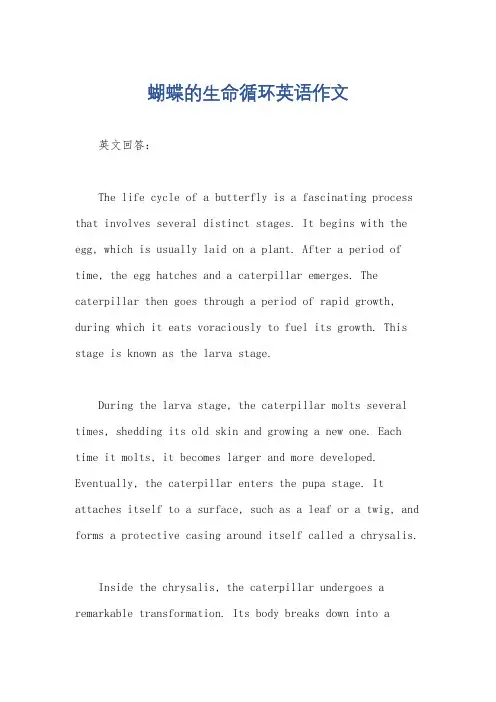
蝴蝶的生命循环英语作文英文回答:The life cycle of a butterfly is a fascinating process that involves several distinct stages. It begins with the egg, which is usually laid on a plant. After a period of time, the egg hatches and a caterpillar emerges. The caterpillar then goes through a period of rapid growth, during which it eats voraciously to fuel its growth. This stage is known as the larva stage.During the larva stage, the caterpillar molts several times, shedding its old skin and growing a new one. Each time it molts, it becomes larger and more developed. Eventually, the caterpillar enters the pupa stage. It attaches itself to a surface, such as a leaf or a twig, and forms a protective casing around itself called a chrysalis.Inside the chrysalis, the caterpillar undergoes a remarkable transformation. Its body breaks down into asoupy substance, and then reforms into a completely different creature – the butterfly. This process is known as metamorphosis. After a period of time, the adult butterfly emerges from the chrysalis, its wings still soft and folded. It takes some time for the wings to expand and dry out, but once they do, the butterfly is ready to fly.The adult butterfly then goes in search of a mate. Once it finds a suitable partner, the female butterfly lays her eggs on a plant, and the cycle begins again.中文回答:蝴蝶的生命周期是一个迷人的过程,涉及几个明显的阶段。
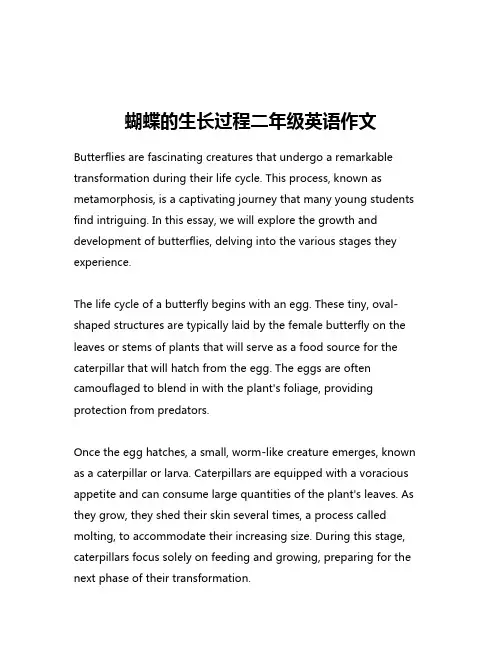
蝴蝶的生长过程二年级英语作文Butterflies are fascinating creatures that undergo a remarkable transformation during their life cycle. This process, known as metamorphosis, is a captivating journey that many young students find intriguing. In this essay, we will explore the growth and development of butterflies, delving into the various stages they experience.The life cycle of a butterfly begins with an egg. These tiny, oval-shaped structures are typically laid by the female butterfly on the leaves or stems of plants that will serve as a food source for the caterpillar that will hatch from the egg. The eggs are often camouflaged to blend in with the plant's foliage, providing protection from predators.Once the egg hatches, a small, worm-like creature emerges, known as a caterpillar or larva. Caterpillars are equipped with a voracious appetite and can consume large quantities of the plant's leaves. As they grow, they shed their skin several times, a process called molting, to accommodate their increasing size. During this stage, caterpillars focus solely on feeding and growing, preparing for the next phase of their transformation.After a period of intense feeding, the caterpillar will enter the pupa or chrysalis stage. This is a remarkable transformation, as the caterpillar literally liquefies inside the protective casing, undergoing a remarkable restructuring of its body. Inside the chrysalis, the caterpillar's tissues break down, and specialized cells called imaginal discs begin to form the various structures of the future butterfly, such as the wings, legs, and eyes.The duration of the pupal stage can vary depending on the species of butterfly, but it typically lasts for several weeks. During this time, the internal changes are taking place, and the caterpillar is slowly transformed into the beautiful winged creature we recognize as a butterfly.Finally, the moment of emergence arrives. The chrysalis splits open, and the newly formed butterfly slowly unfurls its wings. At first, the wings may appear crumpled and damp, but as the butterfly pumps fluid into them, they expand and dry, ready for flight. This process is truly remarkable, as the butterfly has undergone a complete transformation, going from a crawling caterpillar to a graceful, flying insect.Once the butterfly has emerged, it will spend some time resting and allowing its wings to fully harden and dry. During this time, it mayalso take in some nectar from nearby flowers, providing it with the energy it needs for its future adventures. When ready, the butterfly will take to the skies, fluttering from flower to flower, feeding on nectar and playing a vital role in the pollination of plants.The life cycle of a butterfly is a testament to the wonders of nature and the incredible adaptations that have evolved over millions of years. From the delicate egg to the majestic winged creature, the transformation of a butterfly is a captivating process that has long captured the imagination of children and adults alike. By understanding and appreciating the growth and development of these remarkable insects, we can gain a deeper appreciation for the natural world and the intricate web of life that sustains it.。
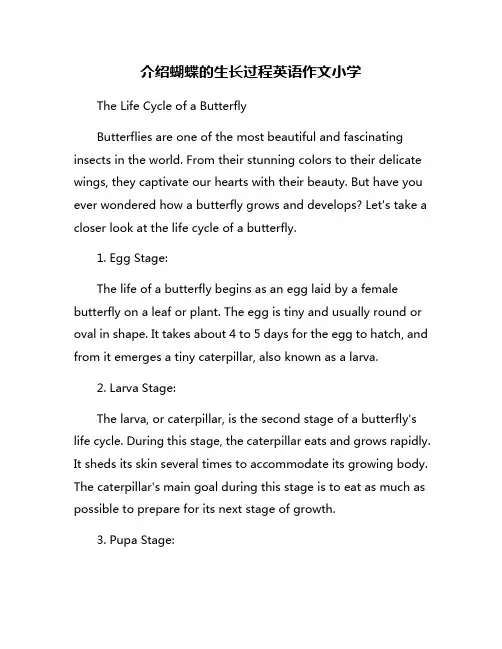
介绍蝴蝶的生长过程英语作文小学The Life Cycle of a ButterflyButterflies are one of the most beautiful and fascinating insects in the world. From their stunning colors to their delicate wings, they captivate our hearts with their beauty. But have you ever wondered how a butterfly grows and develops? Let's take a closer look at the life cycle of a butterfly.1. Egg Stage:The life of a butterfly begins as an egg laid by a female butterfly on a leaf or plant. The egg is tiny and usually round or oval in shape. It takes about 4 to 5 days for the egg to hatch, and from it emerges a tiny caterpillar, also known as a larva.2. Larva Stage:The larva, or caterpillar, is the second stage of a butterfly's life cycle. During this stage, the caterpillar eats and grows rapidly. It sheds its skin several times to accommodate its growing body. The caterpillar's main goal during this stage is to eat as much as possible to prepare for its next stage of growth.3. Pupa Stage:Once the caterpillar has grown to its full size, it forms a protective casing around itself called a chrysalis. Inside the chrysalis, the caterpillar undergoes a remarkable transformation known as metamorphosis. During this stage, the caterpillar completely changes its body structure and turns into a butterfly. This process usually takes about 10 to 14 days.4. Adult Stage:Finally, after the metamorphosis is complete, the butterfly emerges from the chrysalis as an adult. The butterfly's wings are wet and crumpled at first, but they quickly expand and dry out. The adult butterfly will spend the next few weeks feeding on nectar from flowers, mating, and laying eggs to continue the life cycle.In conclusion, the life cycle of a butterfly is truly a remarkable process. From a tiny egg to a beautiful adult butterfly, each stage of growth is a wonder to behold. So the next time you see a butterfly fluttering by, remember the incredible journey it took to get there.。
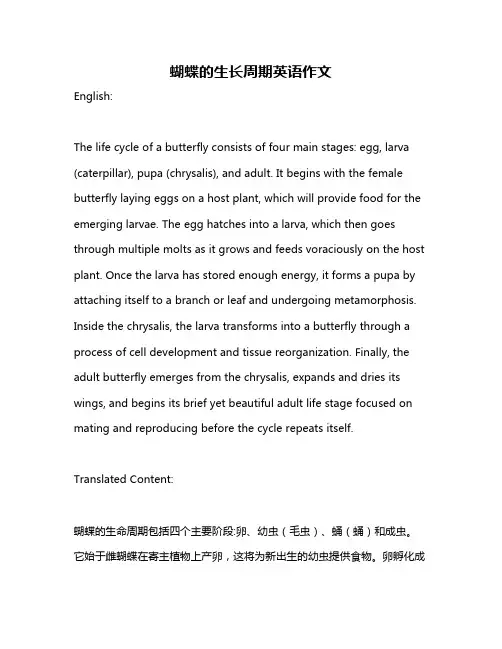
蝴蝶的生长周期英语作文English:The life cycle of a butterfly consists of four main stages: egg, larva (caterpillar), pupa (chrysalis), and adult. It begins with the female butterfly laying eggs on a host plant, which will provide food for the emerging larvae. The egg hatches into a larva, which then goes through multiple molts as it grows and feeds voraciously on the host plant. Once the larva has stored enough energy, it forms a pupa by attaching itself to a branch or leaf and undergoing metamorphosis. Inside the chrysalis, the larva transforms into a butterfly through a process of cell development and tissue reorganization. Finally, the adult butterfly emerges from the chrysalis, expands and dries its wings, and begins its brief yet beautiful adult life stage focused on mating and reproducing before the cycle repeats itself.Translated Content:蝴蝶的生命周期包括四个主要阶段:卵、幼虫(毛虫)、蛹(蛹)和成虫。
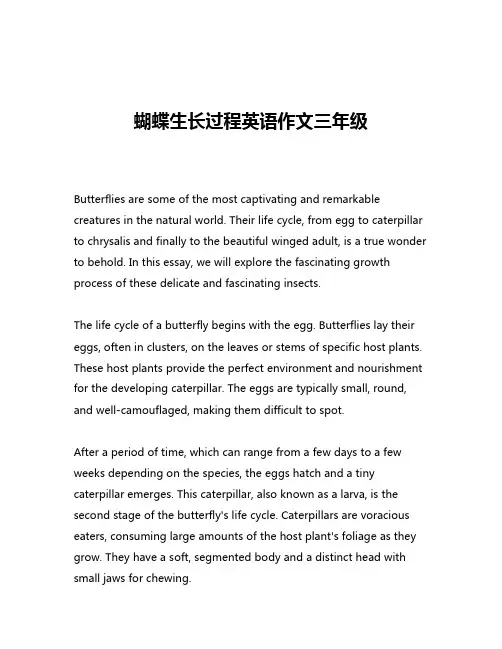
蝴蝶生长过程英语作文三年级Butterflies are some of the most captivating and remarkable creatures in the natural world. Their life cycle, from egg to caterpillar to chrysalis and finally to the beautiful winged adult, is a true wonder to behold. In this essay, we will explore the fascinating growth process of these delicate and fascinating insects.The life cycle of a butterfly begins with the egg. Butterflies lay their eggs, often in clusters, on the leaves or stems of specific host plants. These host plants provide the perfect environment and nourishment for the developing caterpillar. The eggs are typically small, round, and well-camouflaged, making them difficult to spot.After a period of time, which can range from a few days to a few weeks depending on the species, the eggs hatch and a tiny caterpillar emerges. This caterpillar, also known as a larva, is the second stage of the butterfly's life cycle. Caterpillars are voracious eaters, consuming large amounts of the host plant's foliage as they grow. They have a soft, segmented body and a distinct head with small jaws for chewing.As the caterpillar grows, it goes through a series of molts, shedding its exoskeleton to accommodate its increasing size. This process is known as ecdysis, and it allows the caterpillar to continue expanding and developing. During this time, the caterpillar's body undergoes remarkable changes, with new structures and organs forming in preparation for the next stage of its life cycle.After a period of rapid growth and development, the caterpillar will eventually enter the third stage of its life cycle: the chrysalis, or pupa. This is a remarkable transformation, as the caterpillar's body completely reorganizes and restructures itself. Inside the chrysalis, the caterpillar's tissues and organs undergo a process called metamorphosis, where they break down and reform into the structures of the adult butterfly.The chrysalis stage is a critical and vulnerable time in the butterfly's life cycle. During this period, the insect is completely immobile and defenseless, relying on its camouflage and the protection of its surroundings to keep it safe from predators. The duration of the chrysalis stage can vary greatly, ranging from a few weeks to several months, depending on the species.Finally, the moment of emergence arrives, and the adult butterfly breaks free from the chrysalis. This is a truly awe-inspiring sight, asthe delicate, colorful wings of the butterfly slowly unfurl and expand. The butterfly's body is soft and moist at first, but as it pumps hemolymph (the insect equivalent of blood) into its wings, they quickly harden and become strong enough for flight.Once the butterfly's wings are fully expanded and dried, it takes its first tentative flights, testing its newfound ability to soar. This is a critical and vulnerable time, as the butterfly must learn to navigate its environment and find sources of nectar to sustain itself. The adult butterfly's primary purpose is to mate and reproduce, ensuring the continuation of its species.The growth process of butterflies is a remarkable and complex journey, filled with incredible transformations and adaptations. From the tiny, inconspicuous egg to the majestic, winged adult, the butterfly's life cycle is a testament to the wonders of nature and the resilience of living organisms.As we observe and study these captivating creatures, we gain a deeper appreciation for the intricate web of life that surrounds us. Butterflies are not only beautiful to behold, but they also play a crucial role in the ecosystem, serving as pollinators and indicators of environmental health.In conclusion, the growth process of butterflies is a true marvel ofnature, a journey of transformation and adaptation that never fails to inspire awe and wonder. By understanding and appreciating the life cycle of these delicate insects, we can gain a deeper connection to the natural world and the incredible diversity of life that it holds.。
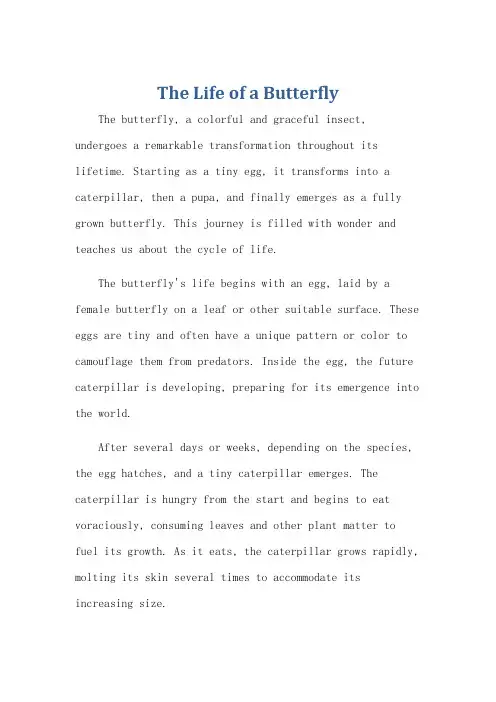
The Life of a ButterflyThe butterfly, a colorful and graceful insect, undergoes a remarkable transformation throughout its lifetime. Starting as a tiny egg, it transforms into a caterpillar, then a pupa, and finally emerges as a fully grown butterfly. This journey is filled with wonder and teaches us about the cycle of life.The butterfly's life begins with an egg, laid by a female butterfly on a leaf or other suitable surface. These eggs are tiny and often have a unique pattern or color to camouflage them from predators. Inside the egg, the future caterpillar is developing, preparing for its emergence into the world.After several days or weeks, depending on the species, the egg hatches, and a tiny caterpillar emerges. The caterpillar is hungry from the start and begins to eat voraciously, consuming leaves and other plant matter tofuel its growth. As it eats, the caterpillar grows rapidly, molting its skin several times to accommodate its increasing size.During this larval stage, the caterpillar not only grows in size but also undergoes physical changes. Some species develop spines or other defenses to protect them from predators. Others may change their color or pattern to blend in with their surroundings.After several weeks or months of eating and growing, the caterpillar is ready to enter the next stage of itslife cycle. It finds a safe place to attach itself, often to a leaf or branch, and forms a chrysalis, a hard protective case. Inside this chrysalis, the caterpillar undergoes a remarkable transformation.The process of metamorphosis is amazing and complex. The caterpillar's body breaks down and reforms into the structures of a butterfly. The wings, antennae, and other butterfly-specific features develop during this time. This process can take days or weeks, depending on the species. Finally, the moment arrives when the butterfly is ready to emerge. It pushes its way out of the chrysalis, its wings still damp and folded. As it rests and dries its wings, the butterfly's colors become more vibrant, and its wings unfold to reveal their full beauty.Once its wings are dry, the butterfly is ready to take flight. It spreads its wings and launches into the air, beginning its new life as a fully grown butterfly. The butterfly will now spend its days feeding on nectar from flowers, mating, and laying eggs to continue the cycle of life.The butterfly's life cycle is a fascinating example of nature's wonders. It teaches us about the power of transformation, the importance of growth and change, and the beauty of the cycle of life. As we observe thebutterfly's journey from egg to caterpillar to butterfly, we are reminded of the amazing processes that shape our own lives and the world we live in.**蝴蝶的一生**蝴蝶,这种色彩缤纷、姿态优雅的昆虫,在其一生中经历了令人惊叹的蜕变。
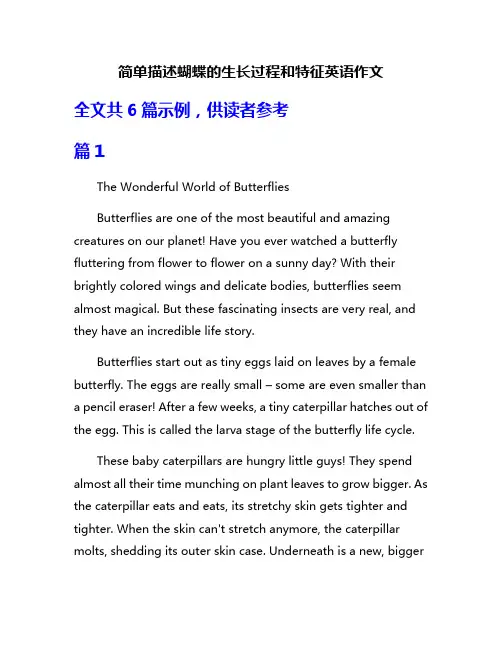
简单描述蝴蝶的生长过程和特征英语作文全文共6篇示例,供读者参考篇1The Wonderful World of ButterfliesButterflies are one of the most beautiful and amazing creatures on our planet! Have you ever watched a butterfly fluttering from flower to flower on a sunny day? With their brightly colored wings and delicate bodies, butterflies seem almost magical. But these fascinating insects are very real, and they have an incredible life story.Butterflies start out as tiny eggs laid on leaves by a female butterfly. The eggs are really small – some are even smaller than a pencil eraser! After a few weeks, a tiny caterpillar hatches out of the egg. This is called the larva stage of the butterfly life cycle.These baby caterpillars are hungry little guys! They spend almost all their time munching on plant leaves to grow bigger. As the caterpillar eats and eats, its stretchy skin gets tighter and tighter. When the skin can't stretch anymore, the caterpillar molts, shedding its outer skin case. Underneath is a new, biggerskin that lets the caterpillar keep growing. Most caterpillars molt four or five times as they get larger and larger.After a few weeks of serious eating, the caterpillar is fully grown. But this isn't the end of its amazing journey – in fact, the most incredible transformation is yet to come! The caterpillar attaches itself to a twig or leaf using a sticky silk pad. Then it molts one last time, shedding its outer caterpillar skin. Underneath is a beautiful chrysalis, also called a pupa.The chrysalis is like a safe cocoon that protects the amazing changes happening inside as the caterpillar turns into a butterfly. For several weeks or months, depending on the butterfly species, the chrysalis may just seem to hang there motionless. But incredible processes are turning the caterpillar body into that of a butterfly – growing wings, legs, antennae and a long, thin mouth tube to sip nectar.Finally, when the transformation is complete, the chrysalis cracks open and a new butterfly slowly emerges! Its wings are shrunken and wet at first, but the butterfly pumps body fluid through them to expand the delicate wings and stiffen the veins. Once its wings are dry and unfurled, this beautiful insect can take to the skies.An adult butterfly's life is usually pretty short, maybe just a few weeks. But in that brief time, it has one very important job –to reproduce and start the life cycle over again. The butterfly flits from flower to flower using its long, coiled mouth tube to drink sweet nectar for energy. When a male and female butterfly mate, the female lays fertilized eggs and the cycle begins anew.Butterflies come in thousands of different species and live all over the world, except in the very coldest places. They come in almost every color of the rainbow and have interesting patterns on their wings that help them blend in or stand out. Some butterflies even migrate long distances, like the famous Monarch butterflies that fly from the United States and Canada all the way to Mexico for the winter!These graceful insects play an important role in nature. As caterpillars, they help control plant growth by eating leaves. And as adults, they pollinate flowers while moving from plant to plant drinking nectar. Without the help of butterflies and other pollinating insects, many plants couldn't reproduce and make seeds or fruit.Aren't butterflies wonderful? From a tiny egg to a plump caterpillar, to a remarkable chrysalis transformation, and finally an beautifully winged adult, the butterfly life cycle is one ofnature's most amazing stories. The next time you see one of these delicate, vibrant insects, watch closely and you'll get a glimpse into an extraordinary world!篇2The Amazing Life of ButterfliesDid you know that there are over 20,000 different kinds of butterflies in the world? They come in so many beautiful colors and patterns. Butterflies are one of the most amazing creatures on our planet, and they have a truly incredible life story!Butterflies go through an amazing process called metamorphosis. This is a very fancy word that means they completely change their body and form as they grow up. It happens in four different stages.The Life Cycle BeginsThe life of a butterfly starts out when a female lays her eggs on a leaf or stem of a plant. Different types of butterflies like to lay their eggs on different kinds of plants. The eggs are really tiny, but if you look closely you can often see cool designs and patterns on them.Once the eggs hatch, teeny tiny caterpillars emerge! This is the first stage that the future butterfly goes through. The caterpillar's only job is to eat and eat and eat! It munches on the leaves of the plant where the egg was laid. As it eats, it grows bigger and bigger and bigger. Pretty soon its rubbery caterpillar skin doesn't fit anymore, so it molts and sheds that skin. It does this several times as it keeps growing larger.The pupa (or chrysalis)After growing really big from eating so much, the caterpillar goes through the next stage and turns into a pupa (some types are called chrysalides instead). This happens when the caterpillar attaches itself to a surface like a twig or rock using a silk pad. Its body then curls up into a beautiful jewel-like case. Inside the case, the caterpillar is rapidly changing and rearranging itself through a process called metamorphosis.During this pupa phase, the caterpillar transforms into a butterfly with wings, a proboscis (long tongue) to sip nectar, compound eyes, and new legs. But it doesn't happen overnight! It takes somewhere between 5 days to several weeks for this magical change to complete.Out of the ChrysalisWhen the transformation is finished, the chrysalis cracks open and an adult butterfly carefully works its way out! Its wings are all crumpled at first after being tightly compacted. The butterfly keeps pumping fluid from its body into the wings to make them expand to their full size and beautiful pattern. After resting for a little while, the new butterfly is then ready to fly off and start its life in the air.The Main Menu: Flowers!Butterflies can't actually eat solid food. Their diet consists only of liquids like nectar from flowers, tree sap, rotting fruits, and water. Using their long hollow tongues (called proboscides), they sip up these nutritious drinks by coiling out their tongues and lapping them up.Their main food is nectar from flowering plants. As they flutter from bloom to bloom sipping nectar, butterflies play a very important role - they pollinate the flowers! Pollen gets stuck to their bodies and legs and then rubs off onto the next flower they land on. This allows the plants to make fruits and seeds. So butterflies and flowers need each other to survive.Senses and SkillsButterflies have some amazing abilities that help them find their flower meals and stay safe. Their big compound eyes are made up of thousands of tiny lenses that let them see colors, patterns, and movements in all directions.They also have sensory receptors on their antennae that can detect smells and tastes from very far away. This helps them sniff out the sweet scents of nectar and find flowers over long distances. Their feet also have taste senses to test if a plant is good to lay eggs on.To protect themselves from predators like birds and wasps, some butterflies have very effective camouflage colorings and patterns on their wings that help them blend in. Some have fake eye spots to scare off enemies, while others taste really gross to birds who try to eat them.Butterfly Garden FriendsButterflies are wonderful guests to have in your garden because they are so colorful and interesting to watch. And don't forget, they help pollinate your plants too! You can attract more butterflies by planting their favorite blooming flowers like zinnias, marigolds, or butterfly bushes.It's also a good idea to avoid using chemical pesticides that could harm them. And you can make a butterfly puddling area by filling a dish or plate with sand and a little bit of water, salt, and overripe fruit. The butterflies will flock to this sweet treat!Next time you see one of these amazing flying flowers, remember the incredible cycle it went through to get there. From a tiny egg to a chubby caterpillar, to a jewel-like chrysalis, and finally an aerial acrobat - the life story of the butterfly is one of the real marvels of nature.篇3The Amazing Life of a ButterflyButterflies are one of the most beautiful and interesting creatures in nature. They go through an amazing transformation called metamorphosis during their life cycle. Let me tell you all about how a butterfly grows and develops into the pretty insect we know.It all starts when a female butterfly lays her eggs on a leaf or stem of a plant. The eggs are really tiny, smaller than a grain of rice! They can be different colors like white, yellow, green or red. The mother butterfly has to choose the perfect plant for her babies as the plant leaves will be their first food when they hatch.After a little while, the eggs hatch into teeny tiny caterpillars called larvae. The larvae looks like a funny little worm with lots of stubby legs. As soon as it is born, the caterpillar starts munching on the leaf it was born on. It just eats and eats and grows and grows. But the caterpillar doesn't stay small for long!The caterpillar grows so quickly that it can't fit in its skin anymore. So what does it do? It sheds its old skin and grows a new bigger one! This is called molting. The caterpillar will molt many times, getting bigger each time. With each molt, the caterpillar might change colors and patterns. Some caterpillars are green to blend in with leaves, while others are brightly colored with stripes or spikes to warn predators that they are poisonous.When the caterpillar is fully grown, it is time for the next stage of the life cycle – the pupa stage. The caterpillar attaches itself to a twig or leaf using sticky silk threads. Then it forms a hard shell called a chrysalis around its body. Inside the chrysalis, an incredible transformation takes place. The caterpillar's body completely breaks down and rebuilds itself into an adult butterfly!After weeks inside the chrysalis, a beautiful butterfly emerges. At first its wings are soft and crumpled, but thebutterfly pumps fluids from its body into the wings to make them grow large and stiff. Once its wings are fully formed, the butterfly can fly!Butterflies come in thousands of different bright colors and patterns on their wings. A butterfly's wings are covered in tiny scales that give them color. These scales overlap in rows like shingles on a roof. The patterns we see are created by different color scales. The patterns help butterflies recognize each other and find mates.Butterflies have two pairs of large wings that are attached to their bodies. They use these wings to fly from flower to flower looking for nectar to eat. Butterflies have a long, curled tube called a proboscis that acts like a straw to sip the sweet nectar.When it's time to lay eggs, the cycle starts all over again! A female butterfly uses her tube-like ovipositor to lay her eggs on plants. She carefully chooses plants that her caterpillar babies will be able to eat.I think the life cycle of the butterfly is simply amazing. Froma tiny egg to a hungry caterpillar to a crysalis and finally transforming into a beautiful, flying insect – it's like a miracle of nature! The bright colors and patterns of butterflies are justmagical. I hope you learned something new about these delicate and fascinating creatures!篇4The Amazing Life of ButterfliesButterflies are one of the most beautiful and interesting insects in the world. With their delicate wings covered in bright colors and patterns, they almost look like little flying works of art! But butterflies aren't just pretty to look at - their lives are full of incredible changes and amazing abilities.When a butterfly starts its life, it looks completely different from how it will end up. It begins as a very tiny egg, laid on a leaf or stem by a butterfly mom. The egg is really small, about the size of a pinhead. After a little while, the egg hatches and out comes a caterpillar!Caterpillars don't look anything like butterflies. They are long, wiggly little creatures with lots of stubby legs. They spend almost all their time eating and eating and eating some more! Caterpillars love to munch on leaves and plants. As they eat, their bodies grow bigger and fatter.But caterpillars have to go through an amazing transformation called metamorphosis to become butterflies. First, the caterpillar attaches itself to a twig or leaf using a sticky silkThread. Then its outer skin splits open and the caterpillar wiggles out of it! What's left behind is a hard protective case called a chrysalis.Inside the little chrysalis case, the caterpillar's body undergoes an incredible change. It turns into a sort of thick liquid goo. Then over the next few weeks, the goo reforms itself into an entirely new creature - a butterfly! The chrysalis case protects the butterfly while this amazing metamorphosis is happening.Finally, the chrysalis cracks open and out emerges a beautiful new butterfly! At first, the butterfly's wings are all crinkled up. It has to pump fluids from its body into the wings to make them unfurl into their full graceful shape. Once the wings are dry, the butterfly is ready to fly off on its brand new life.Butterflies have an amazing ability that very few other insects have - they can taste with their feet! They land on plants using their six fuzzy little legs. The bottoms of their feet are covered in special sensors that can taste if the plant is good forthem to lay eggs on. If the plant tastes right, the female butterfly will lay her eggs there.Another cool butterfly talent is that they can drink using a long, coiled up tongue called a proboscis. When it's time to drink some nectar from flowers, the butterfly unrolls its long tongued tube and sips up the sweet liquid treat. Basically, the butterfly uses its tongue like a tiny little straw!Butterflies often have very bright, vibrant coloring on their wings. The colors and patterns help the butterflies survive in different ways. Some colors help the butterfly blend into its surroundings so predators can't see it. Other bright colors send a warning signal to predators that the butterfly doesn't taste good.Butterfly wings are covered in thousands of tiny scales. These scales are really just flattened hairs made of protein. Each scale's shape and arrangement creates the colors and designs we see through a process called structural coloration. Different scales scatter different wavelengths of light, producing a rainbow of colors!One of the most incredible things about butterflies is their amazing journey to find food and mates. Many kinds of butterflies migrate, which means they travel long distances in search of places with the right plants and environment for them.The most famous migrating butterfly is the Monarch. Every year, millions of Monarch butterflies migrate from the United States and Canada all the way to Mexico for the winter! Their migration covers over 3,000 miles!From tiny, wiggly caterpillars to beautiful winged insects, butterflies are some of nature's most amazing creatures. Their incredible life cycles, special abilities, brilliant colors and long migrations are all part of what makes butterflies such fascinating animals to learn about. The next time a butterfly flutters by, remember what an awesome journey that delicate insect has been through!篇5The Amazing Life of ButterfliesButterflies are some of the most beautiful and interesting creatures in nature. With their bright colors, delicate wings, and incredible journey from a tiny egg to a flying insect, butterflies are truly amazing! Let me tell you all about the wonderful life of these special animals.It all starts when a female butterfly lays her eggs on a leaf or stem of a plant. The eggs are very tiny, but if you look closely you can see they are shaped like little bumps or barrels. The butterflyis very careful to choose a plant that will be the perfect food for her babies when they hatch.After a few days or weeks, the eggs start to shake and wiggle. Tap, tap, tap goes a tiny jaw from inside each egg, chewing a hole to break free. Out comes a teeny, tiny caterpillar or "larva." This is the second stage in a butterfly's life cycle.The caterpillar's first job is to eat the leaf it was born on. Caterpillars have huge appetites and strong jaws to chew and chew all day long. As they eat, caterpillars grow quickly, shedding their skin several times to allow their body to get bigger. Some caterpillars are green and blend into the leaves, while others have bright stripes or spines to warn predators that they don't taste good.After a few weeks of constant eating, the caterpillar's body will go through an incredible transformation called "metamorphosis." First, the caterpillar attaches itself securely to a twig or leaf using a special silk thread. Then it sheds its outer skin one last time to reveal a hard protective covering called a "chrysalis" or "pupa."Inside this chrysalis, the caterpillar's body completely changes. It dissolves into a soupy liquid and rearranges itself into an entirely new form - the butterfly! Arms, legs, wings, and all theother body parts develop from this butterfly soup. After a week or two of metamorphosis, the chrysalis casing splits open and out comes the beautiful adult butterfly.At first, the butterfly's wings are tiny and crumpled. But the butterfly pumps fluid from its body into the wings to make them unfurl and expand into their full graceful shape. Once its wings are dry, the butterfly can take its first flight!Butterflies have two pairs of large wings covered with thousands of tiny scales that give them their bright colors and patterns. The patterns on their wings can camouflage them from predators or act as signals to other butterflies. Butterflies also have a long tongue called a "proboscis" that unrolls like a party blower to sip nectar from flowers.Unlike caterpillars that munch on leaves, adult butterflies can only drink flower nectar or other liquids. Their main purpose is to find a mate and reproduce. Male butterflies use their bright colors and patterns to attract females. After mating, the female searches for the perfect spot to start the cycle all over again by laying her eggs.Most butterflies only live for a few weeks as adults, but some survive for several months by migrating long distances or hibernating through winter. The Monarch butterfly is famous forits incredible migration across thousands of miles from the United States and Canada to forests in Mexico every fall.There are over 20,000 different species of butterflies found all around the world. They come in many brilliant colors like orange, black, yellow, blue, and green. Some butterflies even have clear glass-like wings or wings that look like fallen leaves!No matter where you live, there are probably many different types of butterflies flitting around nearby parks, gardens, or fields. Next time you see one, I hope you'll stop and watch these amazing insects for a while. From their humble beginnings as tiny eggs to their final metamorphosis into stunning flying flowers, butterflies truly are one of nature's most extraordinary miracles.篇6The Amazing Life of ButterfliesButterflies are one of the most beautiful and amazing creatures in nature. Have you ever watched a butterfly fluttering from flower to flower on a sunny day? With their bright colors, delicate wings, and graceful flight, butterflies seem almost magical. But butterflies aren't just pretty to look at - their lives are filled with incredible changes and adventures!Butterflies don't start out looking like the pretty insects we know. In fact, they go through an amazing process called metamorphosis, which means they completely change form as they grow up. Here's how it works:The Life CycleIt all begins when a butterfly lays her tiny eggs on the leaves of a plant. The eggs are really small, about the size of a pin head. After a few days or weeks, the eggs hatch and out comes a tiny, hungry caterpillar or "larva."The caterpillar's main job is to eat and grow bigger and bigger. Caterpillars are eating machines! Some caterpillars can eat twice their weight in a single day. As they eat the plant leaves, caterpillars shed their hard outer skin or exoskeleton several times to allow for growth.After weeks of constant eating, the caterpillar becomesfull-grown. But then something remarkable happens - it attaches itself to a twig or leaf and sheds its outer skin one last time. Underneath is an amazing transformation taking place.The caterpillar is rebuilding and reshaping itself into a beautiful butterfly! This stage is called a "pupa" or chrysalis. The pupa looks like a little boxygen tank or jacket potato attached toa branch. But inside, the caterpillar body is rapidly changing into the butterfly body parts like wings, legs, antennae and a proboscis (a long thin tube for drinking nectar).After about 1-2 weeks of waiting patiently in the safety of the pupa, an adult butterfly emerges! It has to spend some time inflating and drying its wings before it can take its first fluttery flight. This whole process from egg to adult is called "metamorphosis" and it's one of the most fascinating life cycles in nature.Butterfly BodiesOnce the butterfly emerges, its body is divided into three main parts - the head, thorax and abdomen. Let's take a closer look:The HeadThe butterfly's head contains its mouth, eyes, and antennae. The butterfly doesn't have teeth or jaws. Instead, it has a long hollow tube called a proboscis that it uses to sip nectar and water, much like a straw.Butterflies have two huge compound eyes made up of thousands of tiny lenses that let them see all around them. They also have a pair of antennae on their heads that can smell andtaste things in the air. The antennae help butterflies find flowers and mates.The ThoraxThis is the body part in the middle, where the butterfly's two pairs of wings and six legs are attached. The top wings are usually larger and more colorful than the bottom hindwings.A butterfly's wings are made of a thin membrane covered with thousands of tiny scales. These scales are what give butterflies their beautiful colors and patterns. When butterflies first emerge from the chrysalis, their wings are soft and droopy. They need to pump fluids from their bodies into the wings to make them big, flat and stiff for flying.The AbdomenThis is the third and final body segment of the butterfly. The abdomen is mostly hollow and contains the butterfly's digestive system, reproductive organs, and air tubes for breathing.Diet and HabitatAdult butterflies only live for a few weeks, so their main jobs are to mate and lay eggs to begin the life cycle over again. In order to get energy for these important tasks, butterflies drink flower nectar through their long proboscis tube. Some butterflieseven get nutrients from sipping mineral water from puddles or eating rotting fruit.Different types of butterflies can be found on every continent except Antarctica. But they tend to live in warmer climates where there are lots of flowering plants to feed on. Some butterflies migrate long distances to find areas with ideal temperatures and plentiful flowers blooming.Butterflies play an important role in nature by pollinating plants. As they move from flower to flower drinking nectar, pollen sticks to their legs and body and gets transferred to other flowers, allowing the plants to make fruits and seeds. Without butterflies and other pollinators, many plants couldn't reproduce.So those are some of the amazing facts about butterflies and their incredible life journey. From tiny eggs to hungry caterpillars to remarkable pupae transformations into beautiful winged adults, every butterfly life is packed with excitement and wonder. The next time you see one, remember all the adventures it went through to become one of nature's most delicate and graceful insects.。
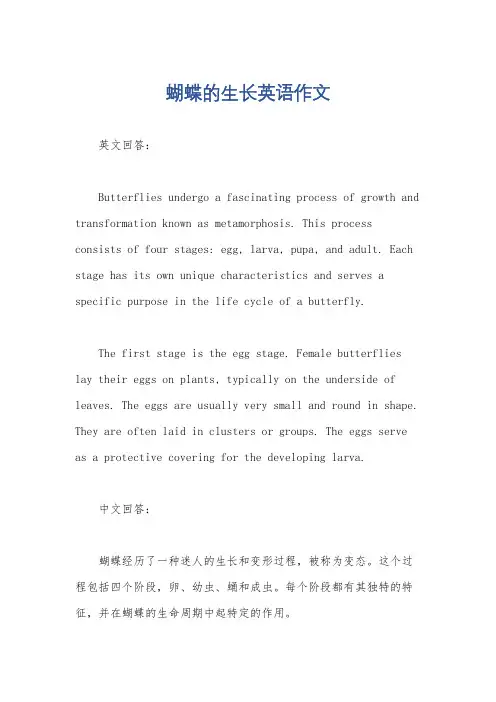
蝴蝶的生长英语作文英文回答:Butterflies undergo a fascinating process of growth and transformation known as metamorphosis. This process consists of four stages: egg, larva, pupa, and adult. Each stage has its own unique characteristics and serves a specific purpose in the life cycle of a butterfly.The first stage is the egg stage. Female butterflies lay their eggs on plants, typically on the underside of leaves. The eggs are usually very small and round in shape. They are often laid in clusters or groups. The eggs serve as a protective covering for the developing larva.中文回答:蝴蝶经历了一种迷人的生长和变形过程,被称为变态。
这个过程包括四个阶段,卵、幼虫、蛹和成虫。
每个阶段都有其独特的特征,并在蝴蝶的生命周期中起特定的作用。
第一阶段是卵阶段。
雌性蝴蝶将它们的卵产在植物上,通常是在叶子的下面。
卵通常非常小而圆。
它们经常以群集或团体的形式产卵。
卵起着保护正在发育的幼虫的作用。
英文回答:After a few days or weeks, the egg hatches and a larva emerges. This is the second stage of a butterfly's life cycle. The larva is commonly known as a caterpillar. Caterpillars have a voracious appetite and spend most of their time eating leaves. They grow rapidly during this stage and shed their skin several times to accommodatetheir increasing size.Caterpillars have a unique feature called prolegs,which are fleshy, stub-like appendages found on the abdomen. These prolegs help the caterpillar to move and cling onto surfaces. Some caterpillars also have special structures called tentacles or horns, which they use for defense against predators.中文回答:几天或几周后,卵孵化出来,一只幼虫出现了。
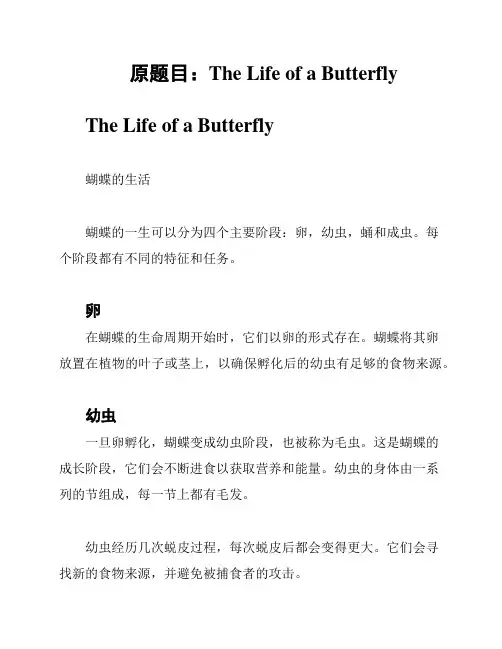
原题目:The Life of a Butterfly The Life of a Butterfly
蝴蝶的生活
蝴蝶的一生可以分为四个主要阶段:卵,幼虫,蛹和成虫。
每
个阶段都有不同的特征和任务。
卵
在蝴蝶的生命周期开始时,它们以卵的形式存在。
蝴蝶将其卵
放置在植物的叶子或茎上,以确保孵化后的幼虫有足够的食物来源。
幼虫
一旦卵孵化,蝴蝶变成幼虫阶段,也被称为毛虫。
这是蝴蝶的
成长阶段,它们会不断进食以获取营养和能量。
幼虫的身体由一系
列的节组成,每一节上都有毛发。
幼虫经历几次蜕皮过程,每次蜕皮后都会变得更大。
它们会寻
找新的食物来源,并避免被捕食者的攻击。
蛹
当幼虫发育到一定阶段时,它们会形成一个蛹。
蛹是蝴蝶的休
眠阶段,在这个阶段,它们几乎不活动,只是待在一个安全的地方。
在蛹的内部,蝴蝶的身体会发生巨大的变化。
它们的组织和器
官会重新排列并形成成虫。
成虫
最终,蝴蝶从蛹中孵化出来,成为成虫。
成虫是蝴蝶的最后一
个阶段,也是最引人注目的阶段。
成虫拥有美丽的翅膀,并且可以飞行。
蝴蝶的主要任务是繁殖,寻找合适的伴侣并产下新一代的卵。
蝴蝶的生命周期是一个奇妙的过程,让我们能够欣赏到它们的
美丽和生命力。
通过了解蝴蝶的生活,我们也能更好地保护它们和
它们所生活的环境。
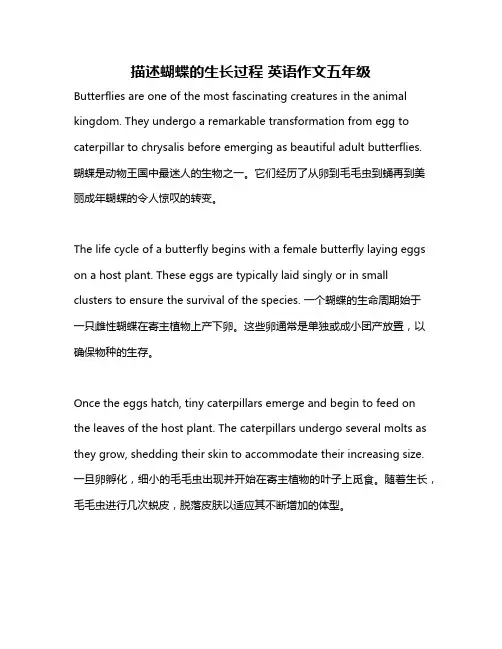
描述蝴蝶的生长过程英语作文五年级Butterflies are one of the most fascinating creatures in the animal kingdom. They undergo a remarkable transformation from egg to caterpillar to chrysalis before emerging as beautiful adult butterflies. 蝴蝶是动物王国中最迷人的生物之一。
它们经历了从卵到毛毛虫到蛹再到美丽成年蝴蝶的令人惊叹的转变。
The life cycle of a butterfly begins with a female butterfly laying eggs on a host plant. These eggs are typically laid singly or in small clusters to ensure the survival of the species. 一个蝴蝶的生命周期始于一只雌性蝴蝶在寄主植物上产下卵。
这些卵通常是单独或成小团产放置,以确保物种的生存。
Once the eggs hatch, tiny caterpillars emerge and begin to feed on the leaves of the host plant. The caterpillars undergo several molts as they grow, shedding their skin to accommodate their increasing size. 一旦卵孵化,细小的毛毛虫出现并开始在寄主植物的叶子上觅食。
随着生长,毛毛虫进行几次蜕皮,脱落皮肤以适应其不断增加的体型。
After reaching a certain size, the caterpillar enters the pupal stage, forming a chrysalis around itself. Inside the chrysalis, the caterpillar undergoes a process of metamorphosis, during which its body transforms dramatically. 成长到一定大小后,毛毛虫进入蛹的阶段,围绕自身形成一个蛹。
The Magical Journey of a ButterflyIn the wonderful world of nature, the life cycle of a butterfly is a fascinating phenomenon. Starting as a tiny egg, it goes through several transformations before finally emerging as a beautiful creature with wings of many colors. Let's explore this magical journey together.The journey begins when a female butterfly lays her eggs on a suitable plant. These eggs are very small and usually green or brown in color, helping them blend in with the surroundings and avoid predators. After a few days, the eggs hatch into tiny larvae, known as caterpillars.The caterpillars are hungry little creatures and feed voraciously on the leaves of the plant. As they grow, they molt several times, shedding their skin to accommodatetheir growing bodies. Each molt brings about changes in their appearance, making them bigger and stronger.After several weeks of feeding, the caterpillar is ready to enter the next stage of its life cycle. It finds a suitable place to attach itself and forms a chrysalis, a hard, protective casing. Inside this chrysalis, thecaterpillar undergoes a remarkable transformation. Its body breaks down into a liquid form and then重组, reshapesinto the body of a butterfly. This process, called metamorphosis, is truly amazing.After a few weeks inside the chrysalis, the butterflyis ready to emerge. It pushes its way out of the chrysalis and expands its wings, which are initially wrinkled and damp. As it warms up and dries its wings, they gradually unfold, revealing the beautiful patterns and colors that make each butterfly unique.The newly emerged butterfly is weak and needs to rest for a while before it can fly. Once it's ready, it takesits first flight, fluttering its wings and dancing in the air. The butterfly now begins its life as an adult, feeding on nectar from flowers and pollinating them as it goes.The adult butterfly lives for a few weeks to a few months, depending on the species. During this time, it mates and lays eggs, continuing the cycle of life. As the end of its life nears, the butterfly finds a suitable place to rest and eventually dies, leaving behind a beautiful legacy in the form of its eggs.The life cycle of a butterfly is a remarkable journey that teaches us about growth, transformation, and thebeauty of nature. From a tiny egg to a beautiful butterfly, this process is a testament to the wonders of creation and the magic of life.**蝴蝶生长的奇妙旅程**在自然界这个奇妙的世界里,蝴蝶的生命周期是一个令人着迷的现象。
英语作文蝴蝶的生长过程Title:The Growth Process of a ButterflyThe life cycle of a butterfly is an amazing transformation, filled with wonder and intricacies. Starting from a tiny egg, it goes through several stages before finally emerging as a beautiful winged creature.The journey begins with the female butterfly laying her eggs on a suitable leaf, often choosing plants that provide nourishment for her offspring. These eggs are minuscule, yet they contain the potential for life.After several days, the eggs hatch into larva, commonly known as caterpillars. These hungry little creatures immediately begin to feed on the leaves of the host plant, as they need a constant supply of nutrients to grow and develop. As they feed, the caterpillars molt several times, growing larger with each phase.Eventually, the caterpillar reaches its final larval stage and prepares for the next phase of its life cycle. It finds a safe spot and spins a silken cocoon around itself. Inside this protective cocoon, the caterpillar undergoes a remarkable metamorphosis. Its body breaks down and reforms, transforming into the adult butterfly.After several weeks inside the cocoon, the butterfly emerges, wings still damp and folded. It rests for a while, allowing its wings to dry and expand. Once ready, the butterfly breaks free from its cocoon and takes its first flight, a symbol of its transformation and newfound freedom.The adult butterfly now spends its days feasting on nectar from flowers, seeking mates, and reproducing the next generation. Its vibrant colors and graceful flight are a testament to the remarkable journey it has undergone. In conclusion, the growth process of a butterfly is a fascinating example of nature's wonders. From a tiny egg to a beautiful winged adult, each stage represents a crucial part of its life cycle, culminating in a creature that is both beautiful and resilient.。
蝴蝶的生长过程英语作文四年级下册Butterflies undergo a remarkable transformation during their growth process. They start out as tiny eggs laid on a leaf by a female butterfly. These eggs hatch into larvae, also known as caterpillars, which feed voraciously on leaves to fuel their rapid growth.蝴蝶在其生长过程中经历了一次非凡的变化。
它们起初是由雌性蝴蝶产在叶子上的微小卵。
这些卵孵化成幼虫,也被称为毛虫,它们贪婪地吃叶子以加速它们的迅速生长。
As the caterpillar grows, it molts several times, shedding its outerskin to accommodate its increasing size. Eventually, the larva enters the pupal stage, where it undergoes metamorphosis inside a protective chrysalis. This transformation is truly remarkable, as the caterpillar's body breaks down into a soupy substance that reorganizes into the body of a butterfly.随着毛虫的成长,它会多次蜕皮,蜕掉外层皮肤以适应其不断增长的体积。
最终,幼虫进入蛹期,在一个保护性的蛹内经历变态。
这种转变真的非常惊人,因为毛虫的身体会分解成一种稀糊状物质,然后重新组织成蝴蝶的身体。
蝴蝶的生命周期英语作文【中英文实用版】The lifecycle of a butterfly is a fascinating journey, starting with an egg, transforming into a caterpillar, and finally emerging as a beautiful adult butterfly.This intricate process is a marvel of nature, showcasing the wonders of metamorphosis.蝴蝶的生命周期是一次奇妙的旅程,从一颗卵开始,变身为毛毛虫,最终化身为美丽的成年蝴蝶。
这个复杂的过程是大自然奇迹的展现,彰显了变态的奇妙。
The initial stage is the egg, laid by a female butterfly on a leaf or stem of a plant.These tiny eggs can come in various shapes and sizes, depending on the species.最初阶段是卵,由母蝴蝶在植物的叶或茎上产下。
这些微小的卵根据种类不同,形状和大小各异。
Following the egg stage, the caterpillar, also known as the larva, emerges.This ravenous creature consumes vast amounts of plant material, molting several times as it grows.在卵阶段之后,毛毛虫,也就是幼虫阶段来临。
这个贪婪的生物大量吞噬植物,随着成长,会蜕皮多次。
ext comes the pupa stage, where the caterpillar transforms into a butterfly.Inside the protective chrysalis, the insect"s body undergoes a remarkable transformation, reorganizing and reshaping into its adult form.接下来是蛹阶段,毛毛虫在此阶段变为蝴蝶。
描述蝴蝶的生长过程英语作文五年级The Growth Process of a ButterflyHave you ever watched a beautiful butterfly fluttering in the air and wondered how it came to be? Well, let's explore the fascinating journey of a butterfly from a tiny egg to a stunning insect.It all starts with a tiny egg. The female butterfly lays these eggs on a leaf, often one that is filled with nutrients. The eggs are small and round, hardly noticeable to the naked eye. Inside the egg, a tiny caterpillar is waiting to be born.After a few days, the egg hatches, and a tiny caterpillar emerges. This caterpillar is very hungry and starts to eat the leaf on which it was born. As it eats, it grows bigger and bigger. You might be surprised to know that caterpillars can eat their own body weight every day!After a few weeks of eating and growing, the caterpillar is ready to enter its next stage. It finds a safe place and creates a small cocoon around itself. Inside this cocoon, the caterpillar undergoes a magical transformation. Its body breaks down and reforms into a completely new shape.After a few more days, the cocoon starts to move. Suddenly, a tiny crack appears, and out comes a beautiful butterfly! Its wings are wet and folded up, but soon they dry and expand. The butterfly rests for a while to get its strength, and then it is ready to fly.So, that's how a butterfly grows from a tiny egg to a stunning insect. It's a fascinating process that shows the beauty of nature and the wonders of life.。
介绍蝴蝶的生长过程英语作文小学The Amazing Life of a ButterflyButterflies are some of the most beautiful creatures in nature, with their bright colors and delicate wings. But did you know that they go through an incredible transformation to become the graceful insects we all admire? Their life cycle is one of the most fascinating things I've ever learned about!It all starts when a butterfly lays her tiny eggs on the leaves of a plant. These eggs are so small that you can hardly see them without a magnifying glass. The mama butterfly has to be very picky about where she puts her eggs because her caterpillar babies will only eat certain types of plants and leaves. For example, monarch butterfly caterpillars can only eat milkweed plants.After a little while, the eggs hatch and out comes a tiny, hungry caterpillar! This is called the larva stage. The caterpillar's main job is to eat as much as it possibly can to grow big and strong. It munches on leaves all day long, getting bigger and bigger. The coolest part is that caterpillars actually molt or shed their skin several times as they outgrow it. I think that's so weird!When the caterpillar can't possibly eat any more food, it's time for the next stage, which is the pupa. This is when the caterpillar transforms into a chrysalis (for most butterflies) or a cocoon (for moths). The caterpillar attaches itself to a twig or leaf and its skin splits open one final time to reveal the chrysalis underneath. It hangs there upside down, looking like a little green or brown capsule.But the real magic is happening inside! If you could see through the chrysalis walls, you would witness an incredible metamorphosis taking place. The caterpillar is basically turning into a liquid goo and rearranging itself into an entirely new creature with wings and legs. How insane is that? It's like a superhero transformation!After a few weeks or months of this extreme makeover, the chrysalis cracks open and out emerges the beautiful, winged adult butterfly! Its wings are all crumpled up at first, but it pumps fluid into them to make them big and straight. Then it flies away to enjoy drinking nectar from flowers and find a mate to start the life cycle over again.Some butterflies migrate really far away for the winter, like the monarchs that fly all the way from Canada and the United States down to Mexico every year. Their journey is thousands ofmiles long! That's like me trying to walk from my house to the moon. I get tired just thinking about it.Butterflies are so important for pollinating plants and keeping our environment healthy. I never get tired of watching them gracefully fluttering from flower to flower. And I find their incredible life story simply amazing - talk about one awesome metamorphosis! From a tiny egg to a hungry caterpillar to a bizarre chrysalis and finally emerging as a beautiful winged insect, they overcome crazy obstacles to become one of nature's true miracles. I hope you'll join me in admiring these special creatures!。